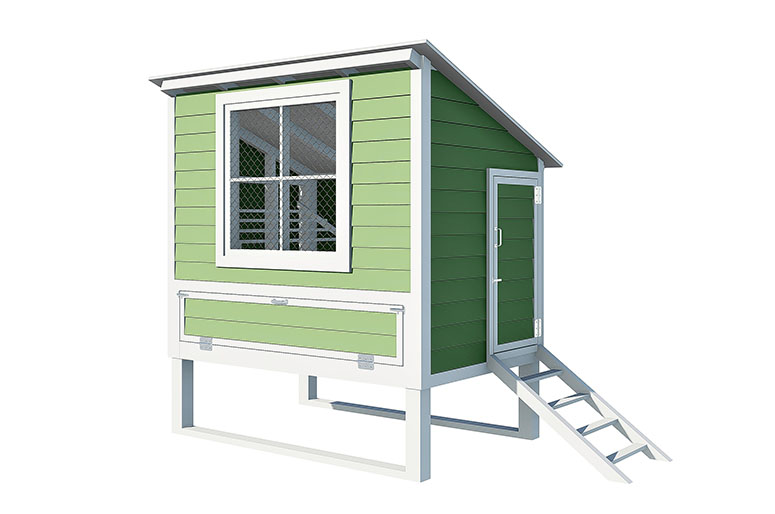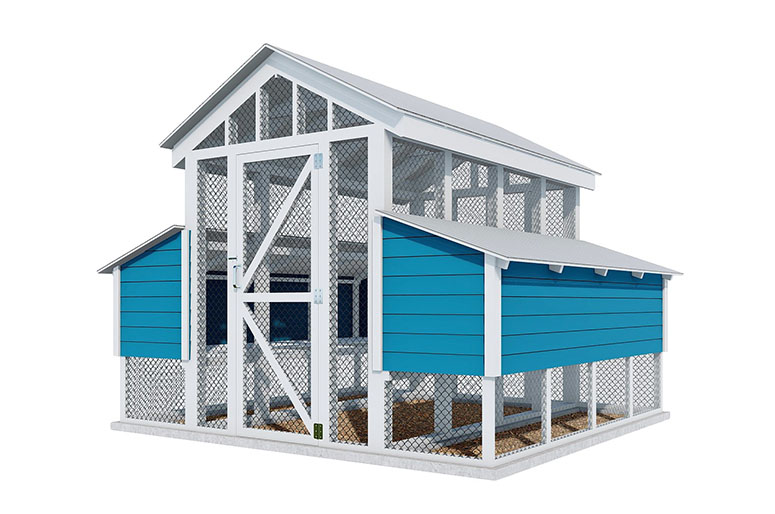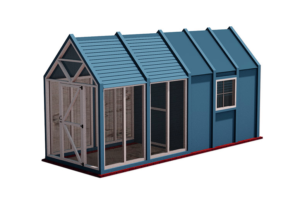Chickens are a great addition to any backyard farm or garden and a practical chicken coop will keep them safe. They have amazing personalities and can be good companions. Once you’ve tried their fresh eggs, you’ll never buy another supermarket dozen. Chickens (and other poultry) can give your kids great lessons in responsibility as they learn to care for the chickens and help build their home.
If you like the benefits of free-range eggs but aren’t ready to let your chickens run completely free in your yard (or neighborhood), a chicken house with a run is a nice alternative. Here are some different ideas and plans for building a practical chicken coop.
The A-frame: Chickens on the go

The A-frame or tractor coop is built with a simple triangular structure and a footprint of 7 x 6 feet. Usually a partial wooden or metal roof is added to one end to provide shelter from the elements. This coop is cheap to put together and is good for beginner chicken owners on a budget.
A-frame coops (also called tractor coops) are designed to move around your yard and can accommodate 5-6 chickens. The portability is better for your lawn since you are moving the chickens often enough to distribute their natural fertilizer. Also, moving the coop daily cuts down on the amount of scratching in one place. You need quite a large yard to be able to move the A-frame every day, and it needs to be situated in a flat area so that the chickens can’t get out. You will need materials such as wood, nails, hinges and door pulls, wire mesh, and galvanized roofing.
Advantages and Disadvantages
The open floor design doesn’t require any cleaning, which is a huge plus for many backyard farmers. Chickens love to scratch the ground in search of bugs and grass seeds, which are great nutrition. Breezes blow through the mesh on the bottom of the frame, while the top box provides shade for your birds when it’s hot. In cold weather, you can run a cord and heat lamp into the coop if you want to add more warmth for your poultry, but that might make moving the frame a bit trickier.
There are a couple of downsides to the A-Frame. Predators like foxes, skunks, raccoons and possums can dig underneath the frame to eat your chickens and/or their eggs. While you could staple mesh to the floor of the frame, you might tear up your yard moving the frame around.
Chickens aren’t always nice to each other. If you have a more aggressive chicken, it may be harder to keep her from picking on other hens.
What is a Chicken Run?
A chicken run is easy to construct and inexpensive to set up, requiring materials like wire, tall stakes or a basic wooden frame. You can cover the top of the run with chicken wire or mesh fabric to protect your flock from hawks and other birds of prey.
The biggest downside of the chicken run is safety: both from the weather and from animal attacks. The chicken run can also be bad for your lawn unless you can move it frequently. Combine a chicken run with a more traditional coop and you chickens will get more exercise, and enjoy pecking and foraging for treats.
Wheeled Coop: safe but small

The portable chicken coop is built on wheels so it’s easy to put your coop exactly where you want it, minimizing the damage to your lawn. A Chicken Run or A-frame can be attached to the portable coop, giving your small flock of 6-8 birds more room to spread their wings and lessen crowding.
Advantages and Disadvantages
The best thing about this 8 x 15 foot portable chicken coop is the combination of safety with the freedom to get to the fresh grass via a chicken run. These coops keep your flock more secure from predators – with the floor raised over the wheels, animals can’t dig under the walls to attack your chickens or their eggs. At night, the door to the run can be secured so that no chickens are left vulnerable outside.
If your family will need to move, a portable chicken coop can be a great option as it is much easier to transport than a fixed coop.
The one disadvantage of a portable chicken coop is that it can be too small. If the coop is small enough to move easily on wheels, it could be cramped inside. Such a small building is hard for humans to move around in when it’s time to collect the eggs, clean out the coop, and do other necessary chores. The movable coop is a great option for just a few birds, enough to supply your family with fresh eggs.
The Traditional Coop: warmth and safety for your feathered friends

The Traditional Coop usually has a fully enclosed 4 x 6 foot roost and nesting box which can accommodate 4-6 chickens. There is a door to close them in at nights, and a ladder giving the birds access to whatever sized chicken run or fenced-in area you choose to build. Your helpers have easy access the eggs, AND the chickens are protected from weather and predators at night. In winter, the coop can be warmed with a heating lamp or closed in with shutters or plastic sheeting. You can also use electricity to power a waterer and keep it from freezing. This coop might make taking care of your chickens on those really cold days a bit easier.
Advantage and Disadvantages of the Traditional Coop
This design gives chickens a little more room inside than the A-frame style and it is much more secure. You don’t have to move it daily, so you don’t need as much space in your yard as you would for an A-frame.
Permanent coops can develop a strong odor, especially in the summer and so it still needs to be cleaned. If you choose to use the deep litter method, you won’t have to clean as often, and you can use the litter and chicken manure as compost.
The Traditional Coop is a little more expensive and complex to assemble than the A-frame. Get your family and friends involved. You all should be able to figure out the plans without trouble. Host a Coop-Raising party. If you don’t have any construction genes at all, there are pre-made coops for purchase, but they will be more expensive.
Unless you include an outdoor run in your design or let your chickens free-range from time to time, the chickens may not get the kind of stimulation they need to be happy and healthy. You can hang vegetables for them to pick and jump at, which will keep them amused.
Walk-In Hen House: next best thing to free-range

Hen houses are more expensive and complicated to build than the portable, smaller coops. The builder in your family would need to be skilled to pull it off. Another possible disadvantage of the full-size hen house is that if your family has to move to another home, it would be a big chore to move the coop. Consider how long you will be in your current home before building a full-size hen house.
If you would like to walk into your coop, the Walk-In Hen House is tall enough (10 feet at the gable). The birds also have enough room to spread their wings and run around a bit. Overcrowded chickens can get sick more easily and also have behavior problems like excessive fighting and pecking.
Advantages and Disadvantages
The Walk-In Hen House is good for a medium size flock of 10-15 birds and has a footprint of 10 x 6 feet. Remember that chickens don’t always lay their eggs in the nice nesting boxes; in this coop, it is easy to grab any stray eggs without having to crawl around. There’s lots of ventilation with the open mesh and easily run electricity should you choose.
Predictably, this is the most complex and expensive coop to build and you will need access to power tools like table saws, routers and probably an industrial stapler. If you want a solid floor, you can trench the site for the coop first and build a concrete one. Sand and deep bedding also works just fine. Cleaning will take you a bit more time, but think of all the compost your birds will help generate.
Large Hen-House: The Ritz

The Large Hen House can house up to 50 birds with a footprint of 8 x 24 feet. A gable vent helps with ventilation as does the mesh and windows. Like the Walk-In Hen House, you can build a concrete floor or a sand and deep bed one.
The Advantage and Disadvantages of both Hen Houses are quite similar. They are permanent structures that will keep your birds safe and give them room to move, but they do need to be cleaned and maintained to keep your birds healthy.
Conclusions
When searching for a design for your new chicken coop, you’ll find there are many options out there. Consider the safety, comfort, and health of your birds before deciding what you want to build. Think about the climate you live in and the budget you’ll need to build the coop. You also need to think about where you’ll keep the chicken feed and other items you need for your birds.
A-Frames and Wheeled coops are suitable for small flocks and help limit the time you spend cleaning the coop. Traditional Coops are more secure and keep your chickens warm and safe from harm. Chicken runs give your flock the feeling of being free-range. If you are more ambitious and want to house a larger flock, the Walk-In and Large Hen Houses give you easy access to hens and eggs, and let the birds move freely. Good luck and enjoy your feathered pals.
Dave Malcolm is a passionate blogger who often writes about woodworking, gardening and, last but not least DIY projects. His goal is to share inspiration, practical suggestions, and comprehensive how-to guides. If you enjoyed reading this article and would like to see more of his work please visit his website: https://www.howtoplans.org













2 Comments
In the first coop if the wire is allowed to extend beyond the bottom in a skirt and then anchored with stones or paving stones, they would still be protected. Move the stones, move the coop, put the stones back. We do that for the garden and it works well (so far).
I’ve read and believe that heat lamps should never be used in any kind of coop. They are a fire hazard and there are safer ways to insulate a coop. Plus chickens wear down coats to keep them warm. Also water should never be left in a coop. This can lead to frostbite on the combs and wattles